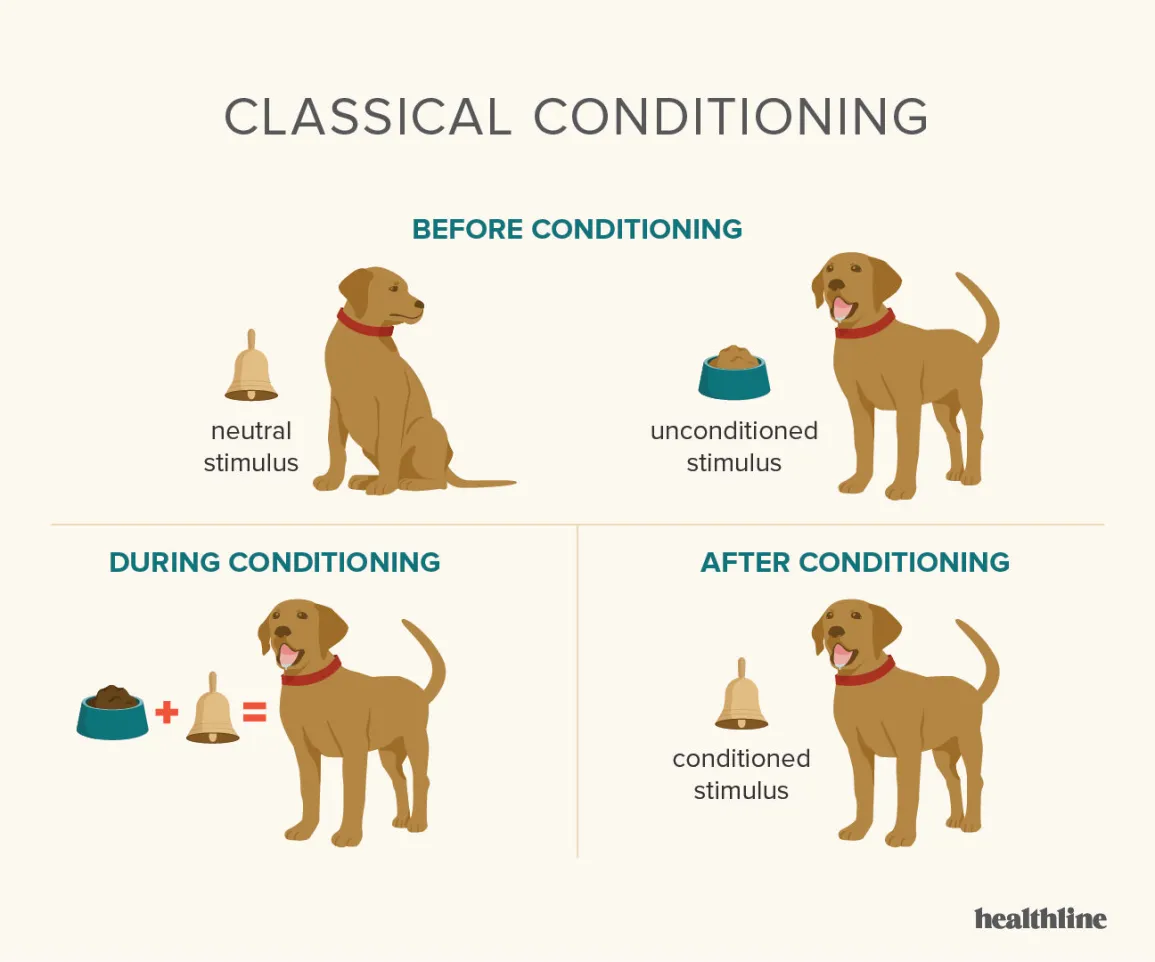Classical conditioning is a fascinating concept in psychology that explains how we learn to associate certain stimuli with specific responses. Ivan Pavlov, a Russian physiologist, first explored this learning process through his famous experiments with dogs. This article will delve into classical conditioning examples to illustrate how this form of learning operates and its applications in everyday life.
What is Classical Conditioning?
Classical conditioning, often called Pavlovian conditioning, is a type of learning in which an organism associates a previously neutral stimulus with a significant one. This process involves pairing a neutral stimulus with an unconditioned stimulus to produce a conditioned response.
Critical Terms in Classical Conditioning
- Unconditioned Stimulus (US): A stimulus that naturally triggers a response without prior conditioning. For example, food can cause salivation in dogs.
- Unconditioned Response (UR): The natural reaction to the unconditioned stimulus. In Pavlov’s experiment, salivation in response to food is an unconditioned response.
- Conditioned Stimulus (CS): A previously neutral stimulus that begins to trigger a conditioned response after being paired with an unconditioned stimulus. In Pavlov’s experiment, the sound of a bell becomes a conditioned stimulus after being paired with food.
- Conditioned Response (CR): The learned response to the conditioned stimulus. In this case, the dogs salivating at the sound of the bell is the conditioned response.
The Process of Classical Conditioning
To understand how classical conditioning works, let’s break it down into a simple process:
- Before Conditioning: The unconditioned stimulus elicits an unconditioned response. For instance, when food (US) is presented, the dog salivates (UR).
- During Conditioning: The neutral stimulus (CS), such as a bell, is presented just before the unconditioned stimulus (US) multiple times. Eventually, the dog learns to associate the bell with the food.
- After Conditioning: The neutral stimulus alone can elicit the response. The dog salivates (CR) when it hears the bell, even without the food being present.
Real-Life Classical Conditioning Examples
Classical conditioning isn’t confined to laboratory experiments; it’s all around us in everyday life. Let’s explore some relatable examples of classical conditioning.
Advertising and Marketing
One of the most prominent areas where classical conditioning is utilized is advertising. Advertisers often pair their products with positive stimuli to create favorable associations in consumers’ minds.
- Example: A commercial might show a refreshing beverage enjoyed at a beach party (positive stimulus) while the product is advertised. This combination makes consumers associate the drink with happiness and fun.
Food Aversion
Another interesting example of classical conditioning is food aversion. This phenomenon occurs when a person associates a particular food with illness, often after just one experience.
- Example: Imagine eating a specific type of sushi and later feeling nauseous. Even if the sushi didn’t cause the illness, you might develop an aversion to it because your body associates it with feeling sick.
Pets and Training
Classical conditioning is commonly used in pet training. Many pet owners unknowingly use this form of conditioning to teach their animals certain behaviors.
- Example: When training a dog, a trainer might give a treat (US) when the dog performs a trick (UR). Over time, the command’s (CS) sound will elicit the desired behavior (CR), even without the threat.
Phobias and Fears
Phobias can often be explained through classical conditioning. After a negative experience, a person might develop an irrational fear of something.
- Example: If someone has a traumatic experience with a dog, they might fear all dogs. The sight of a dog (CS) can trigger anxiety (CR), even if the dog poses no threat.
The Importance of Classical Conditioning in Therapy
Understanding classical conditioning examples can also be significant in therapeutic settings. Therapists often use this knowledge to help patients overcome fears and anxieties.
Exposure Therapy
In exposure therapy, individuals are gradually exposed to the source of their fear while learning to manage their anxiety. This process can effectively change conditioned responses over time.
- Example: If someone is afraid of flying, a therapist might start with discussing airplanes, then move to looking at pictures, and eventually, they might even take a short flight. By repeatedly exposing the individual to the source of their fear in a controlled environment, they can learn to associate flying with calmness instead of anxiety.
Systematic Desensitization
This technique is based on classical conditioning principles and involves gradually exposing a person to their fear while teaching relaxation techniques to counteract the anxiety response.
- Example: A person afraid of heights might first visualize being at a high place while practicing deep breathing exercises. Gradually, they would work their way up to standing on a balcony, pairing the height with relaxation instead of fear.
Classical Conditioning in Everyday Learning
Classical conditioning also plays a crucial role in everyday learning processes. Here are a few instances where it comes into play.
Music and Emotions
Music often evokes emotional responses based on past experiences.
- Example: A song played during a significant event, like a wedding or a graduation, may trigger feelings of happiness and nostalgia when heard again.
Classroom Environment
Teachers frequently use classical conditioning techniques to enhance learning and classroom behavior.
- Example: A teacher might use a bell to signal the end of a lesson (CS). Over time, students learn to pack up their things when they hear the bell, associating it with the transition to the next class (CR).
Social Interactions
Our social interactions are often influenced by classical conditioning as well.
- Example: If someone consistently receives positive feedback when they share ideas in a group setting, they may feel more confident and enthusiastic about participating in future discussions.
The Science Behind Classical Conditioning
Understanding the science behind classical conditioning can enhance our grasp of its practical applications. Here’s a closer look at some foundational studies that have shaped our understanding of this concept.
Pavlov’s Experiment
As mentioned earlier, Ivan Pavlov’s experiments with dogs laid the groundwork for classical conditioning. Here’s a brief overview of his methodology:
- Setup: Pavlov observed that dogs would salivate at the sight of food. He explored this behavior by introducing a neutral stimulus (bell sound) just before presenting food.
- Findings: After repeated pairings, the dogs began to salivate at the sound of the bell alone. This demonstrated that the neutral stimulus could evoke a response after conditioning.
John B. Watson and Little Albert
John B. Watson expanded on Pavlov’s work by demonstrating that classical conditioning could be applied to humans.
- The Experiment: In a controversial study, Watson conditioned a baby named Albert to fear white rats by pairing the presence of the rat (CS) with a loud noise (US) that startled the child (UR). Eventually, Albert began to cry (CR) at the sight of the rat alone.
- Conclusion: This experiment highlighted how emotional responses could be conditioned and had significant implications for understanding phobias and anxieties.
Practical Applications of Classical Conditioning
The principles of classical conditioning are widely applied in various fields, illustrating its versatility beyond psychology.
Education
Teachers can use classical conditioning to foster positive learning environments in educational settings. Here are some techniques:
- Positive Reinforcement: Teachers can use praise or rewards (US) to reinforce desired behaviors (UR) in students. Over time, students may respond positively (CR) to specific cues, like a teacher’s smile or approval.
- Routine Establishment: Using consistent cues, like music or visuals, can help students associate certain times or activities with specific behaviors, enhancing focus and engagement.
Health and Wellness
Health and wellness programs often utilize classical conditioning principles to promote positive behaviors.
- Example: In smoking cessation programs, individuals might use a relaxation technique (CS) while experiencing cravings (US). Over time, they can learn to manage cravings (CR) effectively without resorting to smoking.
Animal Training
Animal trainers frequently employ classical conditioning methods to teach desired behaviors.
- Example: A trainer might use a clicker (CS) to signal when a dog performs a desired action. The sound of the clicker, paired with a treat (US), encourages the dog to repeat the behavior (CR) when they hear the click.
Conclusion: The Power of Classical Conditioning Examples
In conclusion, understanding classical conditioning examples illuminates how we learn, adapt, and respond to the world around us. This powerful psychological concept reveals the connections between our experiences and behaviors, providing insights into everything from advertising to therapy and animal training. By recognizing the role of classical conditioning in our lives, we can harness its principles to create positive changes and foster growth.
As we’ve seen, classical conditioning isn’t just a theoretical concept; it’s an integral part of our daily experiences. Whether it’s learning to associate a song with a memory or overcoming a fear, the implications of classical conditioning are vast and impactful. Embracing this understanding can help us navigate our emotions, enhance our learning, and improve our interactions with others.
In the end, classical conditioning invites us to appreciate the complexities of learning and behavior. It reminds us that we’re all shaped by our experiences, and with the right tools and knowledge, we can foster a more positive and fulfilling life.




